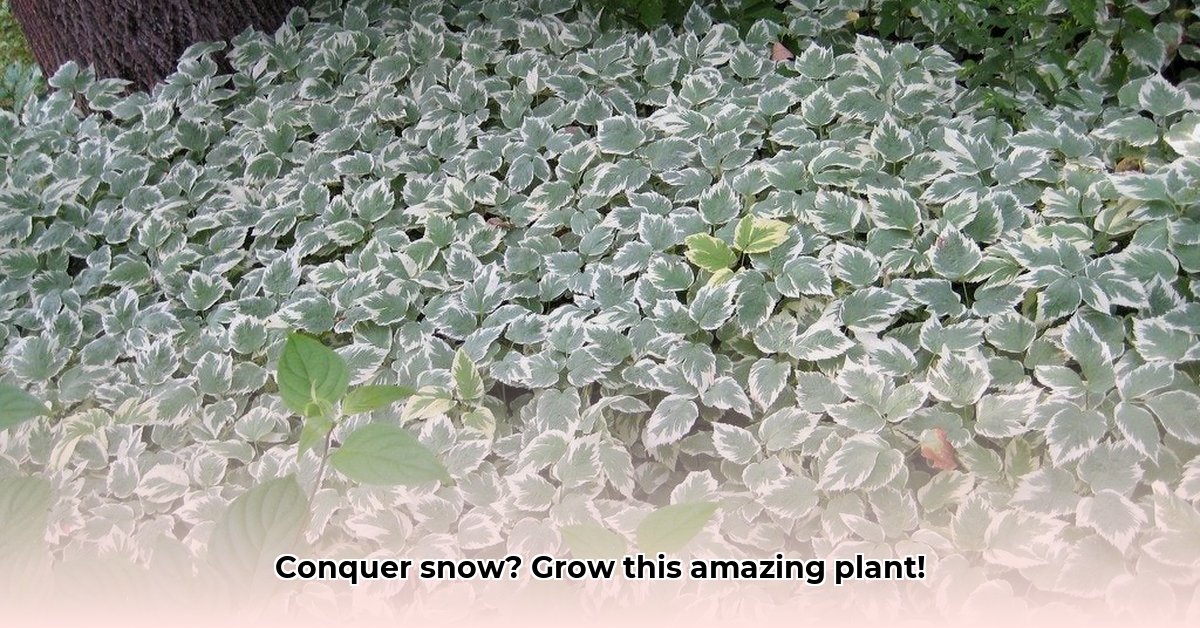
Snow Mountain Gardening Guide: Mastering Euphorbia marginata
Euphorbia marginata, or Snow-on-the-Mountain, is a strikingly beautiful plant with its white bracts contrasting against green foliage. However, its beauty hides a potential problem: its highly invasive nature. This guide provides a comprehensive approach to successfully cultivating Euphorbia marginata while responsibly managing its spread. We’ll cover planting, care, and control methods to ensure you enjoy this plant without ecological consequences. For more information, see this helpful guide: Snow-on-the-Mountain Guide.
Planting Snow-on-the-Mountain: Smart Strategies for a Showy Bloom
Successfully integrating Euphorbia marginata into your garden requires careful planning and proactive management. Think of this plant as a beautiful but potentially unruly guest; it needs boundaries.
Strategic Site Selection: Choose a well-drained location where the plant's spread can be easily monitored and controlled. Consider establishing a dedicated "Snow-on-the-Mountain zone."
Container Cultivation (Highly Recommended): Planting Euphorbia marginata in a large container is the most effective method for controlling its spread. This prevents roots from escaping and invading other areas of your garden.
Barrier Implementation (for In-Ground Planting): If in-ground planting is unavoidable, create a physical barrier (bricks, metal edging, or a deep trench) to restrict root and seed dispersal. This acts as a containment zone.
Deadheading for Seed Control: Regularly remove spent flowers (deadheading) to prevent seed production and subsequent self-seeding, a major contributor to its invasive behavior. This simple step significantly reduces its spread.
Maintaining Your Snow-on-the-Mountain: A Balanced Approach
Ongoing maintenance is key to controlling Euphorbia marginata and maximizing its aesthetic appeal. Proactive monitoring and intervention are essential.
Water Management: Once established, Euphorbia marginata is quite drought-tolerant. However, consistent watering, especially during establishment, promotes healthy growth.
Weed Control: Vigilantly remove any rogue seedlings outside the designated planting area. Prompt removal prevents them from establishing themselves and spreading.
Herbicide Use (Last Resort): Targeted herbicide application is a last resort for aggressive infestations. Always follow label instructions precisely and prioritize environmentally conscious options. Hand removal is often more effective for smaller populations.
Manual Removal: For smaller infestations, diligent hand-removal, ensuring complete root extraction, is effective and environmentally friendly. Always wear gloves to avoid skin irritation from the sap.
Weighing the Pros and Cons: Is Snow-on-the-Mountain Right for You?
| Pros | Cons |
|---|---|
| Drought-tolerant once established | Highly invasive and prone to self-seeding |
| Attracts beneficial pollinators | Sap can cause skin irritation; wear gloves when handling |
| Relatively low-maintenance after establishment | Can easily become a problem weed in inappropriate settings |
| Tolerates poor soil conditions | Requires diligent management to prevent uncontrolled spread |
Safety First: Handling Snow-on-the-Mountain Safely
The sap of Euphorbia marginata can irritate skin. Always wear gloves when handling the plant and wash your hands thoroughly afterward.
Long-Term Snow-on-the-Mountain Management: A Plan for Success
Long-term success requires consistent vigilance and proactive management. Regular monitoring, consistent maintenance, and preventative measures are essential. Consider planting alternative, non-invasive ground covers to further control spread and enhance aesthetic appeal. Responsible gardening protects both your garden and the wider environment.
How to Sustainably Control Invasive Snow-on-the-Mountain Spread
Euphorbia marginata's invasive potential necessitates a multifaceted approach to control its spread. Sustainable management prioritizes methods that minimize environmental impact while effectively limiting its expansion.
Mechanical Control: A Sustainable First Step
Mechanical methods are environmentally friendly and often sufficient for smaller infestations.
- Hand-Pulling: Carefully dig up the entire root system. Wear gloves.
- Mowing: Repeated mowing weakens the plant, but isn't a complete solution.
- Smothering: Covering with thick plastic deprives plants of sunlight.
Chemical Control: A Targeted Approach
Chemical control should be a last resort, used sparingly and responsibly.
- Herbicide Selection: Choose herbicides specifically for broadleaf weeds. Follow label instructions meticulously.
- Timing: Fall application is often most effective.
- Application: Spot treat to minimize environmental impact.
- Safety Precautions: Wear protective gear.
Integrating Mechanical and Chemical Strategies
Combining mechanical and chemical methods is often most effective. Mechanical control limits spread, reducing the area needing herbicide treatment.
Long-Term Management: Prevention is Key
Preventing re-infestation is crucial.
- Regular Monitoring: Regularly inspect for new seedlings.
- Weed Barrier: Install a weed barrier around susceptible areas.
- Planting Alternatives: Plant dense, low-growing plants to out-compete Euphorbia marginata.
Responsible Herbicide Use: Minimizing Risk
A risk assessment matrix helps determine the most appropriate weed control method.
| Risk Factor | Likelihood | Impact | Mitigation Strategy |
|---|---|---|---|
| Non-target damage | Medium | Medium | Precise application, spot treatment |
| Human health exposure | Medium | High | Protective gear, proper mixing and handling |
| Environmental impact | Medium | Medium | Minimal use, environmentally friendly alternatives (when available) |
| Ineffective treatment | Low | Low | Multiple treatments, integration of mechanical methods |
This guide provides a framework. Individual results may vary. Stay informed about the latest research and adapt your approach as needed.